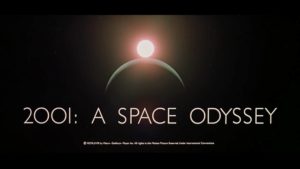Last night I attended a 70mm screening of the classic science-fiction film 2001: A Space Odyssey. Released in 1968 2001 represents what might be considered the pinnacle of cinematic SF before the K/T  event eight years later, Star Wars. While there continued to be released a number of low brow monster and invasion films throughout the 1950s and 1960’s, cinematic SF was, until Star Wars, moving towards a more idea centered adult focused set of stories.
event eight years later, Star Wars. While there continued to be released a number of low brow monster and invasion films throughout the 1950s and 1960’s, cinematic SF was, until Star Wars, moving towards a more idea centered adult focused set of stories.
Directed by Stanley Kubrick and written by Kubrick and Arthur C. Clarke, 2001 deals with the gigantic themes of the origin of humanity and our possible fate. In other essays I have discussed the difference between story and plot with 2001 I want to introduce another approach, the Idea Centered Narrative.
Where story is chiefly concerned with the evolution of a character and that character’s eventual change, and plot is focuses on objectives and the barriers impeding the achievement of those goals, idea driven narratives are concerned with big thoughts and exploring theoretical landscapes. With less focus on individual characteristics idea centered narrative are often more symbolic, impressionistic, and, particularly with film, strikingly visual. This definition fits 2001perfectly.
2001 can be broken down in five acts; 1-The Dawn of Man, 2-Clavius, 3-The Discovery, 4-The Horror of Hal, and 5-Jupiter and Beyond the Infinite. Others has noticed that each act makes a reference to birthdays and births a central and recurring motif throughout the film as it deals with the up-lift of humanity, symbolically shown by way of Bowman’s transformation, into a post-singularity species. Across the five acts there is no single character to follow, Bowman is in three but only in two acts does he service as an audience Point of View. Instead of a singular character, 2001, presents humanity as a whole as its character and the vehicle for its ideas. Humanity transforms, first from a pre-intelligent hominid into a thinking and reasoning animal, then into a complex but divisive species cooperating and competing as individuals and nations, and finally into the cosmic, alien, and unknowable ‘star child.’ This is a movie that is not concerned with any individual’s problems or challenges, not Moonwatcher the hominid, not Hayward the administrator, and not the doomed astronaut Bowman. Rather the central ‘character’, much like how a landscape or a city can be a ‘character’ in a film, is humanity itself and these various individuals stand in for humanity at key moments in its evolution, an evolution that is directed by unseen, unimaginably power, alien intelligences. I find it fascinating that of the five acts it is act that where Kubrick swore off the Hollywood mainstay, the close-up. Bring the camera right into the subject’s face has been thoroughly accepted mechanism for creating intimacy and empathy between the subject and the audience. Across the entire film we have close-up of our heroic astronauts, Bowman and Poole, of non-human characters such as Hal and Moonwatcher, but not when we are with the most human centered aspect of the movie, the discovery of the lunar monolith and the elaborated conspiracy keeping it secret. Instead keeps us at arms length, emotionally distant from all of these characters. I am not sure what I think about this choice; it’s one that I shall ponder for quite awhile.
There’s no doubt that 2001: A Space Odyssey deserves if venation as a cinematic masterpiece. One of the most thoughtful and though-provoking films of any era 2001 stands as giant and seeing it in 70mm was a real treat.
